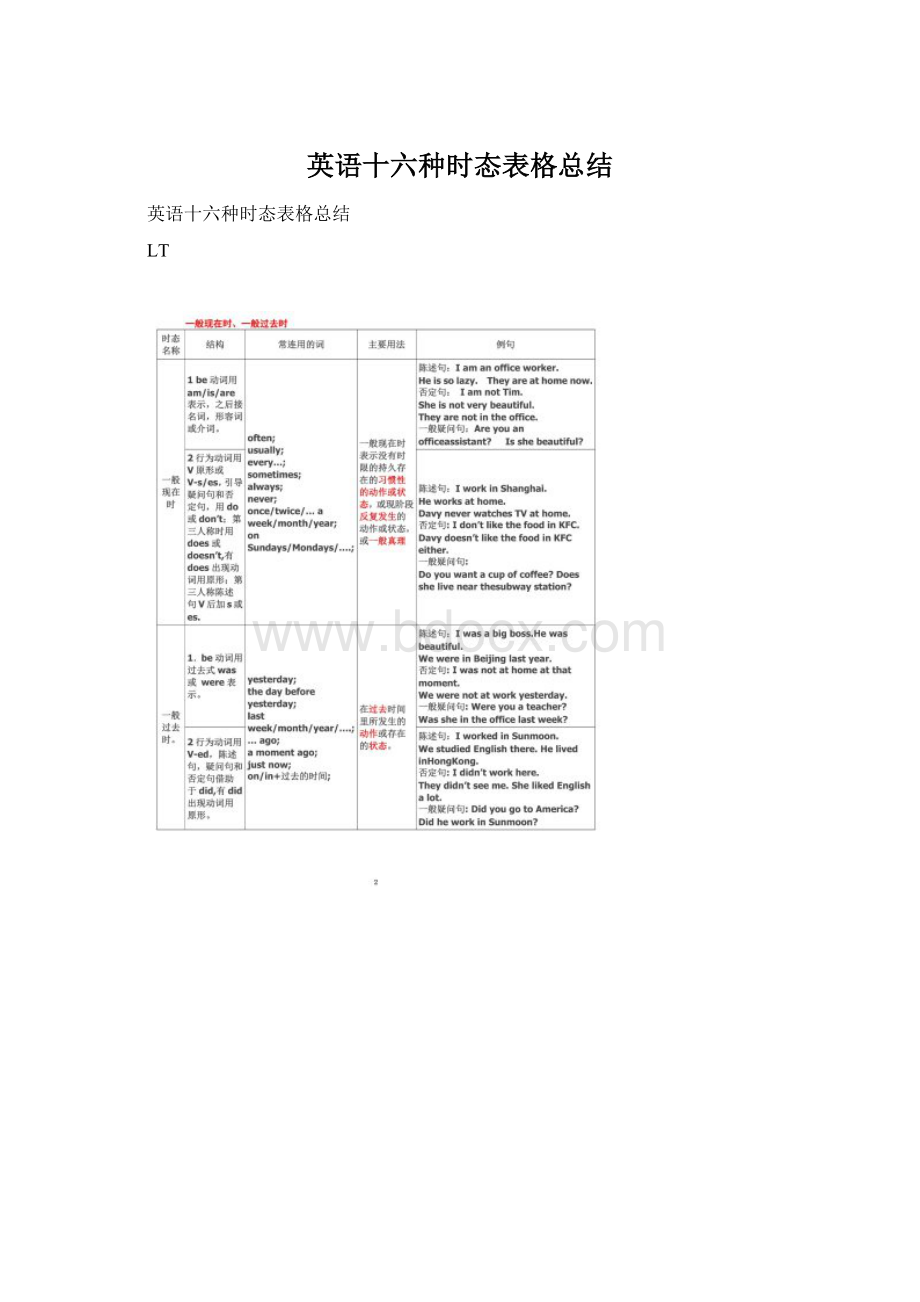英语十六种时态表格总结Word下载.docx
《英语十六种时态表格总结Word下载.docx》由会员分享,可在线阅读,更多相关《英语十六种时态表格总结Word下载.docx(14页珍藏版)》请在冰豆网上搜索。

at+时间点+yesterday/lastnight;
atthatmoment;
过去一段时间正在发生的事情。
Iwasdoingmyhomeworkatthattime.
Wewerehavingapartywhilehewassleeping.
Hewasnotsleepingat11o’clocklastnight.
WereyouwatchingTVatthattime?
Whatwereyoudoingatthatmoment?
现在完成时、过去完成时
现在完成时
have/has+p.p(过去分词)
already;
just;
before;
yet(否定句中);
ever;
never;
once/twice/…
for+一段时间;
since+时间点;
since+一段时间+ago;
by+现在时间;
sofar;
uptonow;
tillnow;
untilnow;
recently/lately;
during/over/inthepast/last….
用来表示之前已发生或完成的动作或状态,其结果的确和现在有联系。
动作或状态发生在过去但它的影响现在还存在;
也可表示持续到现在的动作或状态。
IhavealreadytoldDavy.Davyhasknownthismatter.
Hehaslivedherefornearly10years.
Ihaven’tfinishedmyhomework..
Timhasn’tcomeyet.
Wehaven’theardanynewsabouthim
Hasheworkedheresincehecamehere?
Howlonghaveyouworkedinthiscompany?
特别注意:
1.have/hasalwaysbeen+名词/形容词/介词:
总是或一直是什么样子。
。
Hehasalwaysbeenagoodfather.
Ihavealwaysbeenbusy.
TheyhavealwaysbeeninAmerica.
2.have/hasgoneto:
去了某地(未归)
HehasgonetoBeijing.
Theyhavegonetothecinema.
3.
have/hasbeento:
表示去过或到过某地
IhavebeentoCanada.HaveyoubeentoHongKong?
Wherehaveyoubeen?
Ihaveneverbeenhere.
过去完成时
had+过去分词
过去的过去:
by+过去的时间
(在XX之前,不迟于);
表“过去某动作或时间以前”的时间状语。
动作发生在过去的过去。
HesaidhehadtoldDavy.(间接引语)
HelefttheofficeafterhehadcalledDavy.
Bytheendofthedaywehadsoldover2000tickets.
Shehadn’thaddinnerbeforeshewentout.
HadshelearntEnglishbeforeshemovedhere?
howmanyEnglishwordshadhelearntbytheendoflastyear?
英语时态举例
SimplePresent
一般现在时
SimplePast
一般过去时
SimpleFuture
一般将来时
句子结构:
主语+V
I
study
Englisheveryday.
我每天都学习英语.
主语+V-ed
Twoyearsago,I
studied
EnglishinAmerica.
两年前,我在美国学英语.
主语+will+V.
Ifyouarehavingproblems,I
willhelp
youstudyEnglish.
如果你在学习英语当中,遇到问题,我将帮助你.
主语+begoingto+V
I’mgoingtostudy
Englishnextyear.
我明年将开始学习英语.
PresentContinuous
PastContinuous
FutureContinuous
将来进行时
主语+be+doing
amstudyingEnglishnow.
我正在学习英语.
主语+was/were+doing
wasstudying
Englishwhen
youcalledyeaterday.
你昨天给我打电话的时候,我正在学习英语.
主语+willbe+doing
willbestudying
Englishwhenyouarrivetonight.
明晚你来的时候,我会正在学习英语.
主语+begoingto+be+doing
I’mgoingtobestudying
同上.
PresentPerfect
PastPerfect
FuturePerfect
将来完成时
主语+have/hasdone
havestudied
Englishinseveraldifferentcountries.
在一些国家,我已经学习了英语.
主语+haddone
hadstudied
alittleEnglishbeforeImovedtotheU.S.
在我搬去美国之前,我已经学习了一点英语.
主语+will+havedone
willhavestudied
everytensebythetimeIfinishthiscourse.
在我完成这个课程的时候,我已经能完成英语时态的学习了.
主语+begoingto+havedone
I’mgoingtohavestudied
PresentPerfectContinuous
现在完成进行时
PastPerfectContinuous
过去完成进行时
FuturePerfectContinuous
将来完成进行时
主语+have/hasbeendoing
havebeenstudying
Englishfortenyears.
我已经学习英语有十年的时间了.
主语+hadbeendoing
hadbeenstudying
EnglishfortenyearsbeforeImovedtotheU.S.
在我搬去美国之前,我已经学习了十年的英语了.
主语+willhavebeendoing
willhavebeenstudying
Englishforoverthreehoursbythetimeyouarrive.
明晚你来的时候,我已经学习英语3个小时了.
主语+begoingtohavebeendoing
I’mgoingtohavebeenstudyingEnglishforoverthreehoursbythetimeyouarrive
详细讲解-一般现在时
通常以动词原形表示。
主语为第三人称单数时,用现单三形式。
动词be和have(表示“拥有”)各人称的单数形式为:
第一人称单数
第二人称单数
第三人称单数
Have
Have
Has
Be
Am
Are
is
一般现在时的否定式、疑问式和简单回答形式如下:
动词be与have(表示“拥有”):
否定式直接把not放在动词之后,疑问式直接把动词放在主语之前,见下表:
否定式&
疑问式
Be
Have
Iamnot(I’mnot)…
Ihavenot(haven’t)…
Ami…?
Havei…?
Youarenot(aren’t)…
Youhavenot(haven’t)…
Areyou…?
Haveyou…?
Heisnot(isn’t)…
Hehasnot(hasn’t)…
Ishe…?
Hashe…?
动词be的否定疑问式和简单回答:
否定疑问式
肯定回答
否定回答
AmInot(aren’ti)…?
Yes,youare.
No,youaren’t
Areyounot(aren’tyou)…?
Yes,Iam.
No,I’mnot.
Ishenot(isn’the)…?
Yes,heis.
No,heisn’t
否定式
疑问式
HaveI…?
Areyou…?
动词have(表示“拥有”)的否定疑问式和简单回答:
HaveInot(haven’ti)…?
Yes,youhave.
No,youhaven’t.
Haveyounot(haven’tyou)…?
Yes,Ihave.
No,Ihaven’t.
Hashenot(hasn’the)…?
Yes,hehas.
No,hehasn’t.
注意:
have作为行为动词则只能按照行为动词的规则变化。
行为动词(以study为例)一般现在时的否定式、疑问式和简单回答(注意要加助动词do/does)
Idonot(don’t)study
DoIstudy
Youdonot(don’t)study
Doyoustudy
Hedoesnot(doesn’t)study
Doeshestudy
否定疑问句式
简单回答(肯定/否定)
DoInot(Don’tI)study…?
Yes,Ido.No,Idon’t.
Doyounot(Don’tyou)study…?
Yes,youdo.No,youdon’t.
Doeshenot(Doesn’the)study…?
Yes,hedoes.No,hedoesn’t.
详细讲解-现在进行时、一般过去时
由助动词be+现在分词构成。
其中be有人称和数的变化,有三种形式:
第一人称单数用am,第三人称单数用is,其他用are。
现在进行时的否定式是:
直接在助动词be后面加上not;
疑问式是:
把助动词be提到主语之前。
以study为例:
否定式
Iamnotstudying
AmIstudying?
Youarenotstudying,
Areyoustudying?
Heisnotstudying.
Ishestudying?
一般过去时
一般过去时通常由动词过去式表示。
一般过去时的否定式、疑问式和简单回答形式要用助动词do的过去式did,同时注意实义动词要用原形。
以study为例,其否定式、疑问式和简单回答形式如下:
Ididnot(didn’t)study….
DidIstudy…?
Youdidnot(didn’t)study….
Didyoustudy…?
Hedidnot(didn’t)study….
Didhestudy…?
否定疑问式
简单回答(肯定/否定)
DidInot(Didn’tI)study…?
Yes,youdid.No,youdidn’t.
Diyounot(Didn’tyou)study…?
Yes,Idid.No,Ididn’t.
Didhenot(Didn’the)study…?
Yes,hedid.No,hedidn’t.
详细讲解-过去进行时、过去完成时
由助动词be的过去式+现在分词构成。
其中be有人称和数的变化,第一、第三人称单数用was,其他用were.
1)过去进行时动词主要表示在过去某一时刻或某一段时间内正在进行或持续进行的动作。
过去进行时经常与过去时配合使用。
例如:
Thistimeyesterday,wewerehavinganEnglishlesson.昨天这个时候,我们正在上英语课。
TheteacherwasgivingusalessonwhenTomwalkedintotheroom.
老师在给我们上课时,汤姆走进教室。
Whilewewerehavingsupper,allthelightswentout.我们吃饭的时候,灯灭了。
Hewasreadingwhileshewassettingthetable.她摆桌子时,他在读书。
Itwasgettingdark.Thewindwasrising.天渐渐黑下来了。
风势增强了。
2)过去进行时动词常用always,continually,frequently等词连用,表示过去经常发生的行为。
这种用法表明带有的感情色彩。
Thetwobrotherswerefrequentlyquarrelingwhentheywereyoung.两兄弟小时候常吵架。
InQingDynasty,Chinawasalwaysmakingconcessionstowesternpowers.清朝时,中国总是对西方列强妥协。
过去完成时
一律用had+过去分词构成。
用法:
1)表示发生在过去某一时间或动作之前的事情,即“过去的过去”。
用过去完成时,必须有一个过去的时间或动作来作参照,说明在此之前某事已发生。
如果两个动作都是在过去发生的,先发生的用过去完成时,后发生的用一般过去时。
Shetoldmeshehadbeentherethreetimesbefore.她告诉我她以前到过那里三次。
(“去过”发生在“告诉”之前)
Howlonghadhetaughtherebytheendoflastterm?
到上学期末为止,他在这里教学多长时间啦?
(“教学”发生在上学期末结束之前)
Whenwearrived,thefootballmatchhadalreadybegun.我们到的时候,足球赛已经开始了。
ShehadvisitedChinatwicebeforeshecamethisyear.她今年来中国之前已访问过中国两次了。
2)过去完成时动词可以表示过去某一时刻之前发生的动作或呈现的状态,这一动作一直持续到过去这一时刻或将继续下去。
Bythemiddleoflastmonth,IhadlivedinBeijingforfiveyears.到上月中旬,我已在北京住了五年了。
Bysixo’clocktheyhadworkedforeighthours.到六点为止,他们已工作八小时了。
WhenIcametoShanghai,hehadbeenthereforalongtime.我到上海时,他在那里很长时间了。
3)过去完成时动词常用于间接引语和虚拟语气,我们以后会详细讲述。
4)此外,过去完成时常用于nosooner…than…和hardly(scarcely)…when…这两个句型,前面部分用过去完成时,后面部分用一般过去时。
Nosoonerhadhestolenthepursethanhewascaughtred-handed.=Hehadnosoonerstolenthepursethanhewascaughtred-handed.他刚偷到钱包就被当场抓获。
Saddamhadhardlyrealizedwhatwashappeningwhenhewascaptured.=HardlyhadSaddamrealizedwhatwashappeningwhenhewascaptured.萨达姆还没有意识到在发生什么事情就被抓获了。
详细讲解-过去完成进行时、一般将来时
hadbeen+动词的现在分词。
表示一直持续到过去某个时间的行为动作,此行为动作或刚结束、或还没结束(可以从上下文看出)。
这一时态经常与一般过去时一起使用。
Whenhecamein,IhadbeentryingtorepairtheTVforacoupleofhours.他进来的时候,我一直在努力修理电视机好几个小时了
Theroadsweredangerous.Ithadbeenrainingfortwowholedays.道路很危险。
雨一直下了两整天。
Theyweretiredbecausetheyhadbeendiggingsincedawn.他们累了,因为从天亮开始他们就一直在挖。
Theboywasdelightedwiththenewmountainbike.Hehadbeenhopingforoneforalongtime.那男孩得到一辆新山地自行车很高兴。
很长时间来他一直希望有一辆。
一般将来时
一般将来时动词表示将来发生的动作或情况。
主要有以下几种表现形式:
(1)shall/will+动词原形
表示单纯的将来,不涉及主语的主观意愿。
第一人称I,we用shall或will,其余用will.其否定式、疑问式和简单回答形式如下:
Ishall/willnotstudy….
ShallIstudy…?
Youwillnotstudy….
Willyoustudy…?
Hewillnotstudy….
Willhestudy…?
ShallInot(shan’ti)study…?
Yes,youwill.No,youwon’t.
Willyounot(Won’tyou)study…?
Yes,Is